CBSE class 10 Science Chapter 9 Heredity and Evolution class 10 Notes Science in PDF are available for free download in myCBSEguide mobile app. The best app for CBSE students now provides Heredity and Evolution class 10 Notes and the latest chapter-wise notes for quick preparation for CBSE board exams and school-based annual examinations. Class 10 Science notes on Chapter 9 Heredity and Evolution are also available for download on the CBSE Guide website.
Heredity and Evolution class 10 Notes
CBSE guide notes are comprehensive notes which cover the latest syllabus of CBSE and NCERT. It includes all the topics given in NCERT class 10 Science textbook. Users can download CBSE guide quick revision notes from the myCBSEguide mobile app and my CBSE guide website. Class 10 Science chapter 9 notes have two parts. These are
- Heredity
- Evolution
Let’s discuss them one by one.
Heredity class 10 Notes
Class 10 Science heredity notes include all the topics given in the CBSE syllabus for the current session. Students can download these notes as PDF from myCBSEguide.com/dashboard. These are also available for free on the myCBSEguide app.
Heredity notes class 10 Science broadly discusses how organisms acquire the genetic information of their parents. You can say the inheritance of traits from parents to their children. It is the passing on of traits from parents to their offspring either through asexual reproduction or sexual reproduction.
Evolution class 10 Notes
Evolution is a process that results in changes in the genetic material of a population over time. It is, not something happening every day but it’s a process that takes hundreds of years to reflect noticeable changes. Evolution reflects the adaptations of organisms to their changing environments and can result in altered genes, novel traits, and new species over time.
In this article, we will discuss the main points about evolution as given in the CBSE curriculum document and NCERT book.
10 Science notes Chapter 9 Heredity and Evolution
You can download CBSE class 10th revision notes for Chapter 9 Heredity and Evolution in PDF format for free. These revision notes on Heredity and Evolution class 10 will certainly help students score high in exams. These Heredity and Evolution class 10 Notes are prepared by a team of expert teachers. With the help of these revision notes, you can revise the whole chapter in minutes. Revising notes on exam days is one of the best tips recommended by teachers during exam days.
Revision Notes for Class 10 Science
Class 10 Heredity Notes
Some important definitions
- Genetics: Branch of science that deals with Heredity and variation.
- Heredity: It means the transmission of features/ characters/ traits from one generation to the next generation.
- Variation: The differences among the individuals of a species/population are called variations. It takes place due to environmental changes, crossing over, and recombination of genes and mutation.
- Genotype: The complete set of genes in an organism’s genome is called genotype.
- Phenotype: The observable characteristics in an organism make the phenotype. A phenotype is a modified genotype and many of the phenotypes cannot be inherited.
- Clones are those organisms that are exact copies of each other.
Mendel and His Work on Inheritance
Mendel was known as the Father of Genetics.
- Gregor Johann Mendel (1822& 1884): Started his experiments on plant breeding and hybridization. He proposed the laws of inheritance in living organisms.
- Law of Dominance, Law of segregation, and Law of Independent Assortment.
Plant selected by Mendel
Pisumsativum (garden pea). Mendel used a number of contrasting characters for garden peas.
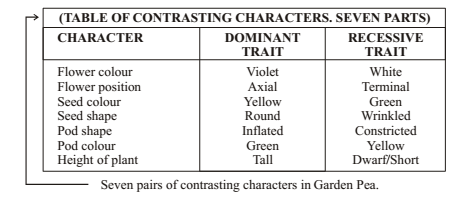
Mendel’s Experiments
Mendel conducted a series of experiments in which he crossed the pollinated plants to study one character (at a time)
- A Cross between two pea plants with one pair of contrasting characters is called a monohybrid cross.
- Cross between a tall and a draft plant (short).

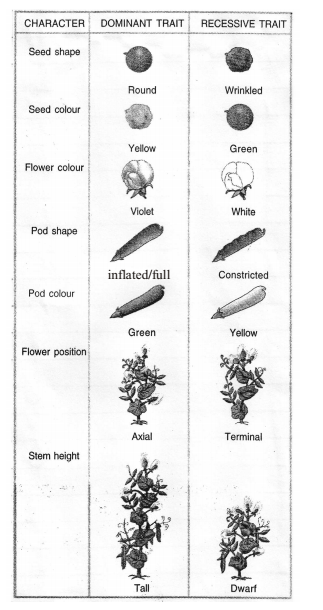

Phenotypic ratio : 3:1
Genotypic ratio : 1:2:1
Phenotype ® Physical appearance [Tall or Short]
Genotype ® Physical appearance [Tall or short]
Observations of Monohybrid Cross
- All F1 progeny were tall (no medium height plant (half way characteristic)
- F2 progeny ¼ were short, 3/4 were tall
- Phenotypic ratio F2 – 3 : 1 (3 tall : 1 short)
Genotypic ratio F2 – 1:2:1
Conclusions of Mendel’s Experiments
- TT and Tt both are tall plants while tt is a short plant.
- A single copy of T is enough to make the plant tall, while both copies have to be ‘t’ for the plant to be short.
- Characters/Traits like ‘T’ are called dominant trait (because it express itself) and ‘t’ are recessive trait (because it remains suppressed)
From these observations, Mendel put forward the rules of inheritance
Law of Segregation
Every individual possesses a pair of alleles for a particular trait. During gamete formation, a gamete receives only one trait from the alleles. A particular trait can be dominant or recessive in a particular generation.
Dihybrid Cross
A cross between two plants having two pairs of contrasting characters is called a dihybrid cross.
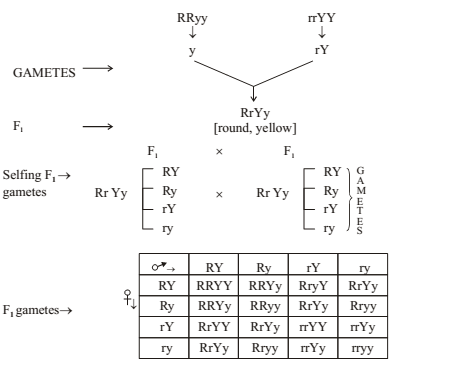
Phenotypic Ratio
Round, yellow : 9
Round, green : 3
Wrinkled, yellow : 3
Wrinkled, green : 1
Observations
- When RRyy was crossed with rrYY in F1 generation all were Rr Yy round and yellow seeds.
- Self-pollination of F plants gave parental phenotype and two mixtures(recombinants round yellow & wrinkled green) seeds plants in the ratio of 9:3:3:1
Conclusions
- Round and yellow seeds are DOMINANT characters
- The occurrence of new phenotypic combinations shows that genes for round and yellow seeds are inherited independently of each other.
Law of Independent Assortment
Alleles of different characters separate independently from each other during gamete formation. In the above example, alleles of texture were assorted independently from those of seed colour.
SEX DETERMINATION
Determination of the sex of an offspring.
FACTORS

Sex Chromosomes
In human beings, there are 23 pairs of chromosomes. Out of these 22 chromosomes, pairs are called autosomes and the last pair of chromosomes that help in deciding the gender of that individual is called the sex chromosome.
XX – female
XY – male
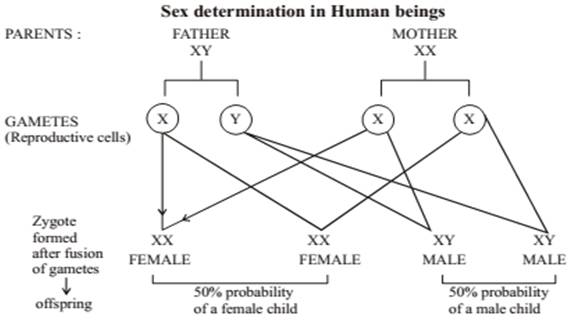
This shows that half the children will be boys and half will be girls. All children will inherit an X chromosome from their mother regardless of whether they are boys or girls. Thus sex of children will be determined by what they inherit from their father, and not from their mother.
Class 10 Evolution Notes
Evolution is the sequence of gradual changes which takes place in primitive organisms, over millions of years, in which new species are produced.
Situation – I
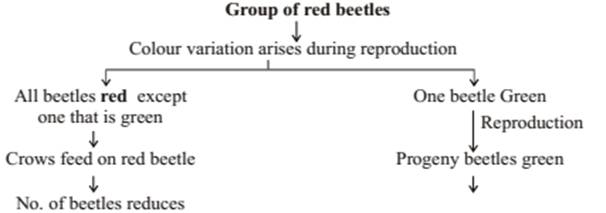
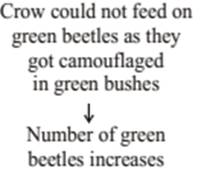
Situation 1: Green beetles got the survival advantage or they were naturally selected as they were not visible in green bushes. This natural selection is exerted by crows resulting in adaptations in the beetles to fit better in their environment
Situation-II
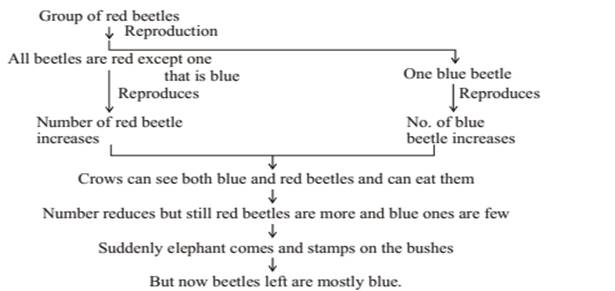
Situation 2: Blue beetles did not get a survival advantage. An elephant suddenly caused major havoc in the beetle population otherwise their number would have been considerably large.
From this we can conclude that accidents can change the frequency of some genes even if they do not get a survival advantage: This is called genetic drift and it leads to variation.
SITUATION-III
Group of red beetles
Habitat of beetles (bushes)
Suffer from plant disease
The average weight of beetles
decreases due to poor nourishment
The number of beetles kept on reducing
Later plant diseases get eliminated
Number and average weight of the beetles
increases again
Situation 3: No genetic change has occurred in the population of beetle. The population gets affected for a short duration only due to environmental changes.
ACQUIRED AND INHERITED TRAITS
They get transferred to the progeny. The low weight of starving beetles3. They are helpful in evolution. eg. Colour of eyes and hair.
| Acquired Traits | Inherited Traits |
| 1. These are the traits that are developed in an individual due to special conditions | 1. These are the traits that are passed from one generation to the next. |
| 2. They cannot be transferred to the progeny | 2. They cannot direct evolution. |
SPECIATION
- Micro Evolution: It is the evolution that is on a small scale. e.g.change in the body colour of beetles. The process by which new species develop from the existing species is known as speciation.
- Speciation: it is the process of formation of new species.
- Species: A group of similar individuals within a population that can interbreed and produce fertile offspring. Factors that lead to speciation: Geographical isolation, genetic drifts and variations.
- Geneflow: It is the exchange of genetic material by interbreeding between populations of the same species or individuals
WAYS BY WHICH SPECIATION TAKES PLACE
Speciation takes place when variation is combined with geographical isolation.
Gene flow: occurs between populations that is partly but not completely separated.

GENETIC DRIFT
It is the random change in the frequency of alleles (gene pair) in a population over successive generations.
*Natural Selection: The process by which nature selects and consolidates those organisms which are more suitably adapted and possess favorable variations
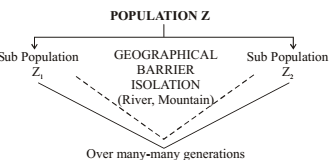
Results in Accumulation of different variations in
Subpopulation and
Genetic drift

Genetic drift takes place due to
- Severe changes in the DNA
- Change in the number of chromosomes
Evolution and Classification
EVOLUTION
The process by which different kinds of living organisms are believed to have developed from earlier forms during the history of the earth
Both evolution and classification are interlinked.
1. Classification of species is a reflection of their evolutionary relationship.
2. The more characteristics two species have in common the more closely they are related.
3. The more closely they are related, the more recently they have a common ancestor.
4. Similarities among organisms allow us to group them together and to study their characteristic.

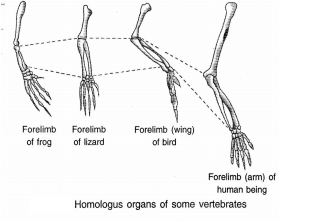
TRACING EVOLUTIONARY RELATIONSHIPS
Jean Baptiste Lamarck gave the first theory of evolution. The accepted one is The Origin of Species by Charles Darwin. (Evidence of Evolution)
I. Homologous Organs
(Morphological and anatomical evidence. These are the organs that have the same basic structural plan and origin but different functions. Homologous organs provide evidence for evolution by telling us that they are derived from the same ancestor.
Example :
| Forelimb of Horse | (Running) | Same basic structural plan, but different functions perform. |
| Winds of bat | (flying) | |
| Paw of a cat | (walk/scratch/attack) |
II. Analogous Organs
These are the organs that have different origins and structural plans but the same function example :
Example: Analogous organs provide mechanisms for evolution.
| Wings of bat | Elongated fingers with skin folds | Different basic structures, but perform similar functions i.e., flight. |
| Wings of bird | Feathery covering along the arm |
III. Fossils : (Paleontological evidence)
The remains and relics of dead organisms of the past.
FOSSILS ARE PRESERVED TRACES OF LIVING ORGANISMS
Fossil Archaeopteryx possess features of reptiles as well as birds. This suggests that birds have evolved from reptiles.
Examples of Fossils
- AMMONITE – Fossil-invertebrate
- TRILOBITE – Fossil-invertebrate
- KNIGHTIA – Fossil-fish
- RAJASAURUS – Fossil dinosaur skull
AGE OF THE FOSSILS

Evolution by Stages
Evolution takes place in stages ie bit by bit over generations.
I. Fitness Advantage
Evolution of Eyes: The evolution of complex organs is not sudden it occurs due to minor changes in DNA, however, takes place bit by bit over generations.

Insects have compound eyes
Humans have binocular eyes
II. Functional Advantage
Evolutions of Feathers
Feathers {/tex} \to {/tex} provide insulation in cold weather but later they might become useful for flight.
Example: Dinosaurs had feathers, but could not fly using feathers. Birds seem to have later adapted the feathers to flight.
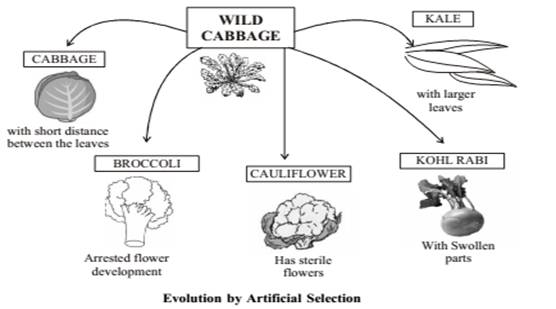
Evolution by Artificial Selection
Humans have been a powerful agent in modifying wild species to suit their own requirements throughout ages by using artificial selection. e.g. (i) From wild cabbage many varieties like broccoli, cauliflower, red cabbage, kale, cabbage and
kohlrabi were obtained by artificial selection. (ii) Wheat (many varieties obtained due to artificial selection).
Molecular Phylogeny
- It is based on the idea that changes in DNA during reproduction are the basic events in the evolution
- Organisms that are more distantly related will accumulate greater differences in their DNA
Tools to Study Human Evolutionary Relationship
- Excavating
- Time dating
- Fossils
- Determining
- DNA Sequences
Although there is the great diversity of human forms all over the world get all humans are a single species
GENETIC FOOTPRINTS OF HUMANS
Hundreds/thousands of years ago
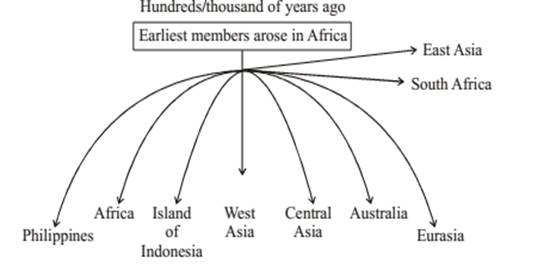
- They did not go in a single line
- They went forward and backward
- Moved in and out of Africa
- Sometimes come back to mix with each other.
Heredity and Evolution class 10 Notes Science
- CBSE Revision notes (PDF Download) Free
- CBSE Revision notes for Class 10 Science PDF
- Revision notes Class 10 Science – CBSE
- CBSE Revisions notes and Key Points Class 10 Science
- Summary of the NCERT books all chapters in Science class 10
- Short notes for CBSE class 10th Science
- Keynotes and chapter summary of Science class 10
- Quick revision notes for CBSE board exams
- Heredity and Evolution class 10 Notes Science
CBSE Class 10 Revision Notes and Key Points
Heredity and Evolution class 10 Notes Science. CBSE quick revision notes for Class-10 Science, Chemistry, Maths, Biology and other subject are very helpful to revise the whole syllabus during exam days. The revision notes cover all important formulas and concepts given in the chapter. Even if you wish to have an overview of a chapter, quick revision notes are here to do if for you. These notes will certainly save you time during stressful exam days.
To download Heredity and Evolution class 10 Notes Science, sample paper for class 10 Mathematics, Science, English Communicative; do check myCBSEguide app or website. myCBSEguide provides sample papers with solutions, test papers for chapter-wise practice, NCERT solutions, NCERT Exemplar solutions, quick revision notes for ready reference, CBSE guess papers and CBSE important question papers. Sample papers all are made available through the best app for CBSE students and the myCBSEguide website.
- Chemical Reactions and Equations class 10 Notes Science
- Acids Bases and Salts class 10 Notes Science
- Metals and Non-metals class 10 Notes Science
- Carbon and its Compounds class 10 Notes Science
- Periodic Classification of Elements class 10 Notes Science
- Life Processes class 10 Notes Science
- Control and Coordination class 10 Notes Science
- How do Organisms Reproduce class 10 Notes Science
- Light Reflection and Refraction class 10 Notes Science
- Human Eye and Colourful World class 10 Notes Science
- Electricity class 10 Notes Science
- Magnetic Effects of Electric Current class 10 Notes Science
- Sources of Energy Current class 10 Notes Science
- Our Environment class 10 Notes Science
- Management of Natural Resources class 10 Notes Science

Test Generator
Create question paper PDF and online tests with your own name & logo in minutes.
Create Now
Learn8 App
Practice unlimited questions for Entrance tests & government job exams at ₹99 only
Install Now